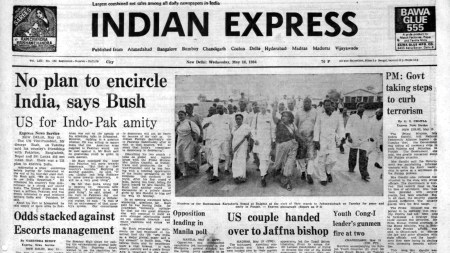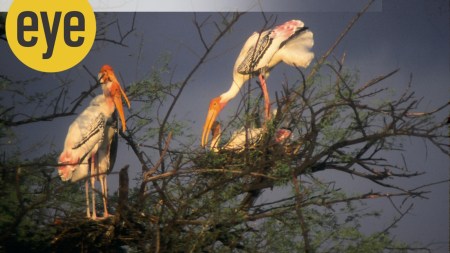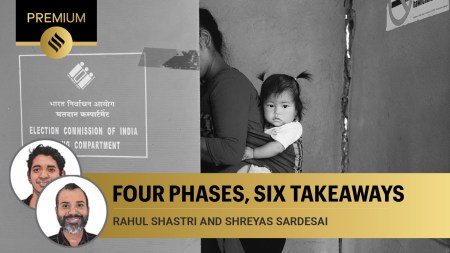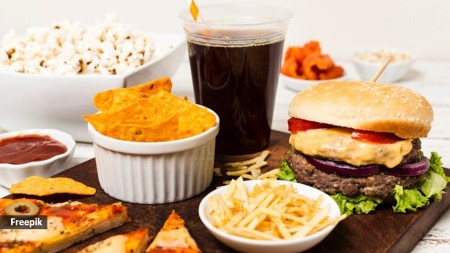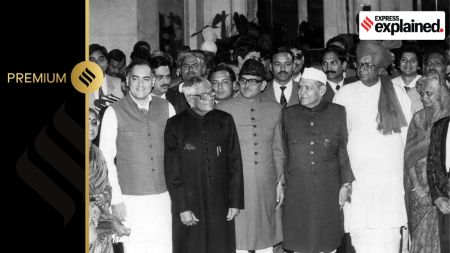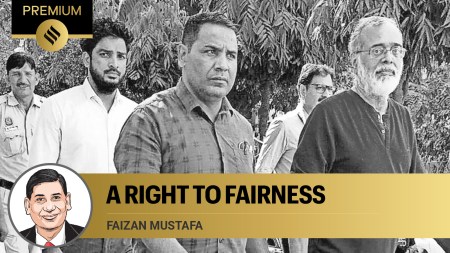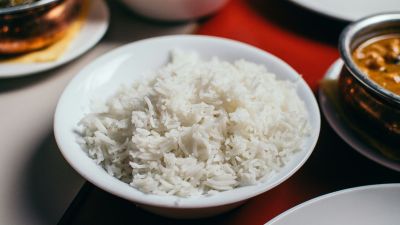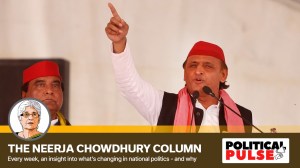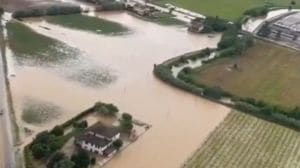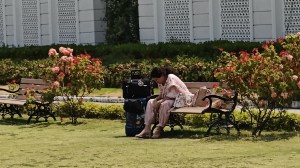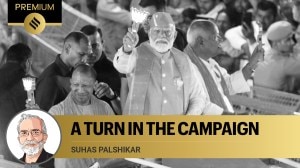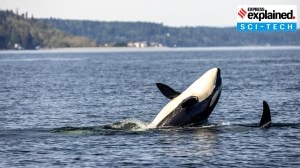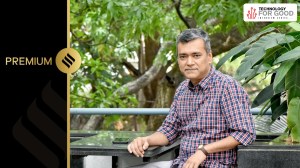- India
- International
UPSC Weekly Current Affairs Quiz | April 21 to April 27, 2024
Brush up your current affairs knowledge with this week's top 15 questions and consolidate your UPSC-CSE preparation. Find answers along with explanations at the end of the quiz.
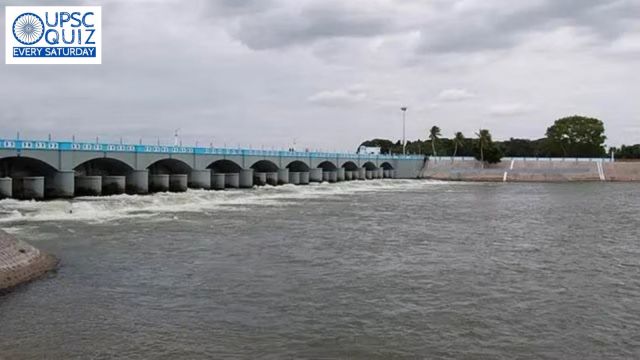 Notably, river basins like Brahmaputra, Narmada and Tapi are marked as having better-than-normal storage levels, whereas basins like Cauvery and east flowing rivers between Mahanadi and Pennar are classified as highly deficient. Find a question on reservoirs of southern India in today's quiz. (File Image)
Notably, river basins like Brahmaputra, Narmada and Tapi are marked as having better-than-normal storage levels, whereas basins like Cauvery and east flowing rivers between Mahanadi and Pennar are classified as highly deficient. Find a question on reservoirs of southern India in today's quiz. (File Image)UPSC Weekly Quiz is a current affairs-based quiz on relevant topics from the past week, curated for the aspirants of competitive examinations. Attempt the weekly quiz every Saturday and find answers to the MCQs with explanations at the end of the article.
🚨 The Indian Express UPSC Essentials brings to you the April edition of its monthly magazine. Click Here to read. Share your views and suggestions in the comment box or at manas.srivastava@indianexpress.com🚨
QUESTION 1
With reference to the India-Japan relations, consider the following statements:
1. The India-Japan Fund has been established by both countries to invest in sustainability projects.
2. Ex Dharma Guardian is a joint military exercise between India and Japan.
3. Both countries are developing a semiconductor supply chain partnership.
How many of the statements given above are correct?
(a) Only one
(b) Only two
(c) All three
(d) None
QUESTION 2
With reference to the heat waves, consider the following statements:

1. A severe heat wave is declared if the departure from normal temperature exceeds 6.4 notches.
2. The threshold for a heat wave is 30°C for Plains and atleast 25°C for Hilly regions.
Which of the statements given above is/are correct?
(a) 1 only
(b) 2 only
(c) Both 1 and 2
(d) Neither 1 nor 2
QUESTION 3
Consider the following dams:
1. Nagarjuna Sagar
2. Tungabhadra
3. Srisailam
What is the correct chronological order of these dams from north to south?
(a) 1—2—3
(b) 2—3—1
(c) 1—3—2
(d) 3—1—2
QUESTION 4
With reference to the forest fires, consider the following statements:
1. The India State of Forest Report recorded that approximately 36% of India’s forest cover was prone to frequent fires.
2. Evergreen forests are prone to severe fires.
3. During the last year, the highest number of forest fires have been reported from Uttarakhand.
How many of the statements given above are correct?
(a) Only one
(b) Only two
(c) All three
(d) None
QUESTION 5
With reference to the organ transplants, consider the following statements:
1. National Organ and Tissue Transplantation Organisation (NOTTO) ID is generated for the donor and recipient for living-donor as well as deceased-donor transplants.
2. Under living near related donors, the donor should be other than near relative of recipient or patient.
3. Commercial trading of organs is allowed under Indian laws.
How many of the statements given above are correct?
(a) Only one
(b) Only two
(c) All three
(d) None
QUESTION 6
With reference to the G7 group of countries, consider the following statements:
1. It has binding impact on policy and all decisions and commitments made at G7 meetings.
2. The member countries represent 40% of global GDP and 10% of the world’s population.
3. The G7 draws its roots from a meeting between the current G7 members after the recession due to the OPEC oil embargo.
4. India is a founding member of the G7 group.
How many of the statements given above are correct?
(a) Only one
(b) Only two
(c) Only three
(d) All four
QUESTION 7
With reference to the principles of the Outer Space Treaty, consider the following statements:
1. Outer space will be free for exploration and use by all states.
2. States will be liable for damage caused by their space objects.
3. Outer space is not subject to national appropriation by claim of sovereignty.
4. States will not place nuclear weapons or other weapons of mass destruction in orbit or on celestial bodies or stations.
How many of the statements given above are the governing principles of Outer Space Treaty?
(a) Only one
(b) Only two
(c) Only three
(d) All four
QUESTION 8
The terms “moraine-dammed and ice-dammed” were recently in news. They are associated with:
(a) Floods
(b) Glacial lakes
(c) Vegetation in hilly region
(d) Valley landform
QUESTION 9
Consider the following pairs:
(Place) (Location)
1. Agaléga Maldives
2. Darfur Egypt
3. Thiou Libya
How many of the pairs given above are correct?
(a) Only one
(b) Only two
(c) All three
(d) None
QUESTION 10
With reference to the Shanghai Cooperation Organisation (SCO), consider the following statements:
1. It is a permanent intergovernmental international organisation established as a successor of the Shanghai Five.
2. The Secretariat of SCO is situated in Xinjiang.
3. The official language of the SCO is English.
How many of the statements given above are correct?
(a) Only one
(b) Only two
(c) All three
(d) None
QUESTION 11
With reference to “High-Ambition Coalition” (HAC), seen in news, consider the following statements
1. This is a coalition of around 65 nations consists of African nations and United States.
2. It wants to end plastic pollution by 2040, phase out “problematic” single-use plastics, and ban certain chemical additives that could carry health risks.
3. The EU which has not joined the HAC said it wants to end plastic pollution by 2040 but unlike the HAC, it advocates that countries should take voluntary steps to end plastic pollution.
How many of the above statements are correct?
(a) Only one
(b) Only two
(c) All three
(d) None
QUESTION 12
With reference to Semiconductor industry, consider the following statements :
1. The Indian government has created a dedicated task-force called the India Semiconductor Mission, which aims to serve as a focal point for an efficient implementation of India’s chip ambitions.
2. More than 90 per cent of the world’s most advanced chips required for almost all electronic equipment such as smartphones, car components, data centres, fighter jets and AI technologies, are made in South Korea.
Which of the above statements is/are correct?
(a) 1 only
(b) 2 only
(c) Both 1 and 2
(d) Neither 1 nor 2
QUESTION 13
With reference to Ethylene Oxide, recently seen in news, consider the following statements:
1. While ethylene oxide effectively kills bacteria, fungi, and insects, it is used as a fumigant in food products.
2. Improper use or excessive application of ethylene oxide in the food supply chain, particularly in the spice industry, where hygiene standards require strict microbial control, has led to significant contamination issues and should be regulated due to its carcinogenic nature.
3. Substances such as ozone, hydrogen peroxide, or heat treatments could serve as potential replacements for ethylene oxide in certain applications.
How many of the above statements are correct?
(a) Only one
(b) Only two
(c) All three
(d) None
QUESTION 14
Consider the following statements with reference to redisribution of privately owned property:
1. Article 39(b) places an obligation on the state to create policy towards securing “the ownership and control of the material resources of the community are so distributed as best to subserve the common good”.
2. In State of Karnataka v Shri Ranganatha Reddy (1977), a seven-judge Bench held that privately owned resources fall within the ambit of “material resources of the community”.
Which of the above statements is/are true?
(a) 1 only
(b) 2 only
(c) Both 1 and 2
(d) Neither 1 nor 2
QUESTION 15
Consider the following countries and answer the question below:
1. Russia
2. China
3. United States
4. India
5. Saudi Arabia
According to the latest report by Stockholm International Peace Research Institute (SIPRI) states, the correct arrangement of countries in descending order of the military spending is:
(a) 1-2-3-4-5
(b) 3-2-1-4-5
(c) 5-4-3-2-1
(d) 3-1-2-5-4
ANSWERS TO THE MCQs
1. (c)
FYI:
— The Ministry of External Affairs (MEA) said the 10th Round of India-Japan Consultations on Disarmament, Non-Proliferation and Export Control was held in Tokyo.
— Recently, the armies of India and Japan conducted the fourth edition of joint military exercise, ‘Ex Dharma Guardian’, at Camp Imazu in Japan’s Shiga province. Hence, statement 2 is correct.
— India’s quasi-sovereign wealth fund, the National Investment and Infrastructure Fund (NIIF), and the Japan Bank for International Cooperation (JBIC) launched a $600-million fund to invest in sustainability projects. Hence, statement 1 is correct.
— JBIC will contribute 51% of that figure, and India the rest, the Indian government said in a statement.
— The Union Cabinet has approved a Memorandum of Cooperation (MoC) between India and Japan on developing a semiconductor supply chain partnership, which will focus on research and development (R&D), manufacturing, design, and talent development for the industry. Hence, statement 3 is correct.
Therefore, option (c) is the correct answer.
2. (a)
FYI:
— The scorching heat wave that has been sweeping significant sections of east India has persisted unabated and has moved to the country’s south, according to the India Meteorological Department.
— Heatwave to severe heatwave conditions are expected in parts of West Bengal, Karnataka, Odisha, Tamil Nadu, Bihar, Sikkim, Telangana, Uttar Pradesh and Jharkhand during the next five days.
— A heat wave is a period of exceptionally high temperatures that exceed the normal maximum temperature during the summer season in North-Western India.
— Heat Waves should not be considered until the highest temperature at a station reaches at least 40°C for plains and 30°C for hilly regions. Hence, statement 2 is not correct.
— When the actual maximum temperature remains 45°C or higher, regardless of the normal maximum temperature, heat waves should be declared. A severe heat wave is declared if the departure from normal temperature exceeds 6.4 notches. Hence, statement 1 is correct.
Therefore, option (a) is the correct answer.
(Other Source: ndma.gov.in)
3. (c)
FYI:
— According to a recent Central Water Commission report, the southern area, which includes the states of Andhra Pradesh, Telangana, Karnataka, Kerala, and Tamil Nadu, has dramatically reduced water storage compared to historical averages, accounting for only 17% of reservoir capacity.
— The reduced storage levels in the southern region are indicative of worsening water scarcity and potential challenges for irrigation, drinking water supply and hydroelectric power generation in these states.
— Water levels at major dams like as Nagarjuna Sagar and Srisailam (in Andhra Pradesh and Telangana), Tungabhadra, and Ghataprabha (in Karnataka) have been falling.
— The correct order of these dams from north to south is Nagarjuna Sagar, Srisailam and Tungabhadra.
Therefore, option (c) is the correct answer.
4. (a)
FYI:
— Forest fires in Uttarakhand’s Nainital region have been raging for more than 36 hours, prompting the Indian Air Force and Army to intervene.
— The fire that broke out in the forest near Nainital district headquarters spread to the residential High Court Colony in the Pines area, disrupting traffic flow.
— According to the biennial India State of Forest Report (ISFR) released by the Forest Survey of India (FSI) under the Ministry of Environment, Forest and Climate Change in 2019, more than 36% of India’s forest cover was prone to frequent fires. Hence, statement 1 is correct.
— In India, the forest fire season lasts from November to June, with hundreds of thousands of minor and big fires burning each year, particularly beginning in February as summer approaches. April and May are often the worst fire months around the country.
— Severe fires break out in dry deciduous forests, while evergreen, semi-evergreen, and montane temperate forests are comparatively less prone to fires. Hence, statement 2 is not correct.
— The forests of Northeast India, Odisha, Maharashtra, Jharkhand, Chhattisgarh, and Uttarakhand are the most prone to fires from November to June.
— The highest number of forest fires have been reported from Mizoram (3,738), Manipur (1,702), Assam (1,652), Meghalaya (1,252), and Maharashtra (1,215), as per FSI data. Hence, statement 3 is not correct.
Therefore, option (a) is the correct answer.
5. (a)
FYI:
— The Centre has directed the states to ensure that a NOTTO (National Organ and Tissue Transplantation Organisation) ID is generated for the donor and recipient for living-donor as well as deceased-donor transplants. Hence, statement 1 is correct.
— NOTTO-ID is mandatory for considering allocation of organ in case of deceased-donor transplant.
— Organs of the deceased donor are anonymously allocated to people waiting for a transplant, while an organ can be donated by a living person only if they (donor and recipient) are close relatives or share a close bond and want to donate altruistically.
— Commercial trading of organs is not allowed under Indian laws. Hence, statement 3 is not correct.
— Living donation should be done after 18 year of age.
Different types of living organ donations
— In Living Near Related Donors, Parents, siblings, children, grandparents, and grandchildren are typically the only immediate blood relatives approved as donors (THOA Rules 2014). Spouses are also approved as living donors under the category of near relatives and are able to donate. Hence, statement 2 is not correct.
— Living Non- near relative Donors are not a near relative of the recipient or patient. They can only gift out of affection and attachment to the recipient, or for any other unique cause.
— SWAP Donors: In circumstances when the live near-relative donor is incompatible with the receiver, provision for exchanging donors between two such pairings exists, when the donor of the first pair matches with the second recipient and the donor of the second pair matches with the first recipient. This is only permitted for close relatives to donate.
Therefore, option (a) is the correct answer.
(Other Source: notto.mohfw.gov.in)
6. (b)
FYI:
— Prime Minister Narendra Modi has received an invitation from his Italian counterpart Giorgia Meloni to attend the G7 Summit Outreach Session in Italy in June.
— The G7 draws its roots from a meeting between the current G7 members, excluding Canada, that took place in 1975. Hence, statement 3 is correct.
— The Group of 7 (G7) is an informal group of seven countries — the United States, Canada, France, Germany, Italy, Japan and the United Kingdom, the heads of which hold an annual summit with European Union and other invitees. Hence, statement 4 is not correct.
— The member countries represent 40% of global GDP and 10% of the world’s population. Hence, statement 2 is correct.
— It has no binding impact on policy and all decisions and commitments made at G7 meetings need to be ratified independently by governing bodies of member states. Hence, statement 1 is not correct.
— The G7 summit provides a forum for member countries to discuss shared values and concerns.
— The G7 Summit has been the birthplace for several global initiatives:
(i) In 1997, the G7 countries agreed to provide $300 million to the effort to contain the effects of the reactor meltdown in Chernobyl.
(ii) In 2002 summit, members decided to launch a coordinated response to fight the threat of AIDS, Tuberculosis and Malaria.
Therefore, option (b) is the correct answer.
7. (d)
FYI:
— It establishes the principles that govern states’ exploration and use of outer space, including the Moon and other celestial bodies.
— The pact entered into force in October 1967, after being approved by Russia, the United Kingdom, and the United States of America.
— It lays down the following governing principles:
(i) The exploration and use of outer space will be carried out for the benefit and in the interests of all countries and will be the province of all mankind.
(ii) Outer space will be free for exploration and use by all states. Hence, statement 1 is correct.
(iii) Outer space is not subject to national appropriation by claim of sovereignty. Hence, statement 3 is correct.
(iv) States will not place nuclear weapons or other weapons of mass destruction in orbit or on celestial bodies or station them in outer space in any other manner. Hence, statement 4 is correct.
(v) The Moon and other celestial bodies will be used exclusively for peaceful purposes.
(vi) Astronauts will be regarded as the envoys of mankind.
(vii) States will be responsible for national space activities whether carried out by governmental or non-governmental entities.
(viii) States will be liable for damage caused by their space objects. Hence, statement 2 is correct.
(ix) States shall avoid harmful contamination of space and celestial bodies.
Therefore, option (d) is the correct answer.
8. (b)
FYI:
— ISRO said that 130 of the 676 lakes are situated in India, in the Indus (65), Ganga (7), and Brahmaputra (58) river basins. These lakes have expanded as glaciers are retreating at an ever faster rate due to global warming.
— The movement of glaciers causes erosion and creates depressions in the surrounding topography. When they retreat, meltwater starts to accumulate in such depressions, giving birth to glacier lakes.
— ISRO categorised glacial lakes into four broad categories based on how they were formed — moraine-dammed, ice-dammed, erosion-based, and ‘others’.
— Moraine and ice-dammed lakes are formed when water is dammed by moraine — debris such as rocks and soil left during the movement of glaciers — and ice respectively.
— Erosion-based lakes are formed when water is dammed by erosion-created depressions.
Therefore, option (b) is the correct answer.
9. (d)
FYI:
| Place in news | Location |
| Agaléga | Mauritius |
| Darfur | Sudan |
| Thiou | Burkina Faso |
Therefore, option (d) is the correct answer.
10. (a)
FYI:
— India emphasised on the need to adopt a “zero-tolerance approach” towards terrorism in all its forms for prosperity and development of the Shanghai Cooperation Organisation (SCO) member states.
— “During the meeting, a protocol was signed by the defence ministers of all SCO member states. A Joint Communique was issued after the meeting, in which the SCO defence ministers agreed, amongst other initiatives, to developing the idea of ‘One Earth, One Family, One Future’, which is rooted in the ancient Indian philosophy of ‘Vasudhaiva Kutumbakam’.”
— The Republic of Kazakhstan, the People’s Republic of China, the Kyrgyz Republic, the Russian Federation, the Republic of Tajikistan, and the Republic of Uzbekistan formed the Shanghai Cooperation Organisation (SCO) on June 15, 2001, in Shanghai (PRC). It succeeded the Shanghai Five mechanism. Hence, statement 1 is correct.
— The SCO’s top decision-making body is the Council of Heads of State (CHS). It meets once a year to make decisions on all of the Organization’s critical concerns.
— The Organisation has two permanent bodies: the Secretariat in Beijing and the Executive Committee of the Regional Anti-Terrorist Structure (RATS) in Tashkent. Hence, statement 2 is not correct.
— The official languages of the SCO are Russian and Chinese. Hence, statement 3 is not correct.
— Members of SCO are the Republic of India, the Islamic Republic of Iran, the Republic of Kazakhstan, the People’s Republic of China, the Kyrgyz Republic, the Islamic Republic of Pakistan, the Russian Federation, the Republic of Tajikistan, the Republic of Uzbekistan
Therefore, option (a) is the correct answer.
(Other Source: eng.sectsco.org)
11. (a)
FYI:
— It is a coalition of around 65 nations — known as the “High-Ambition Coalition” — which seeks to tackle plastic production. The coalition, which includes African nations and most of the European Union, also wants to end plastic pollution by 2040, phase out “problematic” single-use plastics, and ban certain chemical additives that could carry health risks. Hence, statement 1 is not correct and statement 2 is correct.
— The US has not joined the HAC. While it has said it wants to end plastic pollution by 2040, unlike the HAC, it advocates that countries should take voluntary steps to end plastic pollution. “The underlying reason why the US is not ambitious is we are a fossil gas country,” US Senator Jeff Merkley (Democrat from Oregon) told the Associated Press. Hence, statement 3 is not correct.
Therefore, option (a) is the correct answer.
12. (a)
FYI:
— Taiwan is home to some of the leading names in chipmaking, including the likes of Taiwan Semiconductor Manufacturing Company (TSMC) which counts Apple and Nvidia among its clients, and United Microelectronics Corporation (UMC). More than 90 per cent of the world’s most advanced chips required for almost all electronic equipment such as smartphones, car components, data centres, fighter jets and AI technologies, are made in Taiwan. Hence, statement 2 is not correct.
— The Indian government has created a dedicated task-force called the India Semiconductor Mission, which aims to serve as a focal point for an efficient implementation of New Delhi’s chip ambitions. All land-related clearances for the four semiconductor facilities that have been approved so far – three assembly operations that include Micron’s packaging plant and one fab – were done expeditiously, as the Centre worked with the state governments of Gujarat and Assam where these operations are being set up. Hence, statement 1 is correct.
Therefore, option (a) is the correct answer.
13. (c)
FYI:
What is ethylene oxide?
— Ethylene oxide contamination in Indian products mainly originates from the agricultural and food processing sectors, says Dr Pranav Honnavara Srinivasan, senior consultant, Gastrointestinal Surgery, Gastrointestinal Oncology at Sparsh Hospital Bengaluru. “This chemical is often used as a sterilising agent to reduce microbial load in spices, dried vegetable products, and other food commodities susceptible to bacterial contamination during processing and storage.”
— While ethylene oxide effectively kills bacteria, fungi, and insects, he says, its use as a fumigant in food products is regulated due to its carcinogenic nature. Hence, statement 1 is correct.
— Improper use or excessive application in the food supply chain, particularly in the spice industry, where hygiene standards require strict microbial control, has led to significant contamination issues. Hence, statement 2 is correct.
Alternatives to ethylene oxide in food processing
— Dr Srinivasan asserts, “Exploring safer chemical alternatives that have similar antimicrobial properties without carcinogenic risks is crucial.” Substances such as ozone, hydrogen peroxide, or heat treatments could serve as potential replacements for ethylene oxide in certain applications. Hence, statement 3 is correct.
Therefore, option (c) is the correct answer.
14. (a)
FYI:
— Falling under Part IV of the Constitution titled “Directive Principles of State Policy” (DPSP), Article 39(b) places an obligation on the state to create policy towards securing “the ownership and control of the material resources of the community are so distributed as best to subserve the common good”. DPSP are meant to be guiding principles for the enactment of laws, but are not directly enforceable in any court of law. Hence, statement 1 is correct.
— Since 1977, the apex court has weighed in on the interpretation of Article 39(b) on multiple occasions — most notably, in State of Karnataka v Shri Ranganatha Reddy (1977). This case saw a seven-judge Bench, by a 4:3 majority, holding that privately owned resources did not fall within the ambit of “material resources of the community”. However, it was Justice Krishna Iyer’s minority opinion which would become influential in years to come. Hence, statement 2 is not correct.
Therefore, option (a) is the correct answer.
15. (b)
FYI:
— With military expenditure worth $83.6 billion in 2023, India was the fourth largest spender globally in 2023, the latest report by Stockholm International Peace Research Institute (SIPRI) states. This was a result of growing personnel and operations costs that comprised about 80 per cent of the total military budget, the report said.
— The latest data showed that the United States, China and Russia remained the top three military spenders globally followed by India and Saudi Arabia.
Therefore, option (b) is the correct answer.
Subscribe to our UPSC newsletter and stay updated with the news cues from the past week.
May 18: Latest News
- 01
- 02
- 03
- 04
- 05



